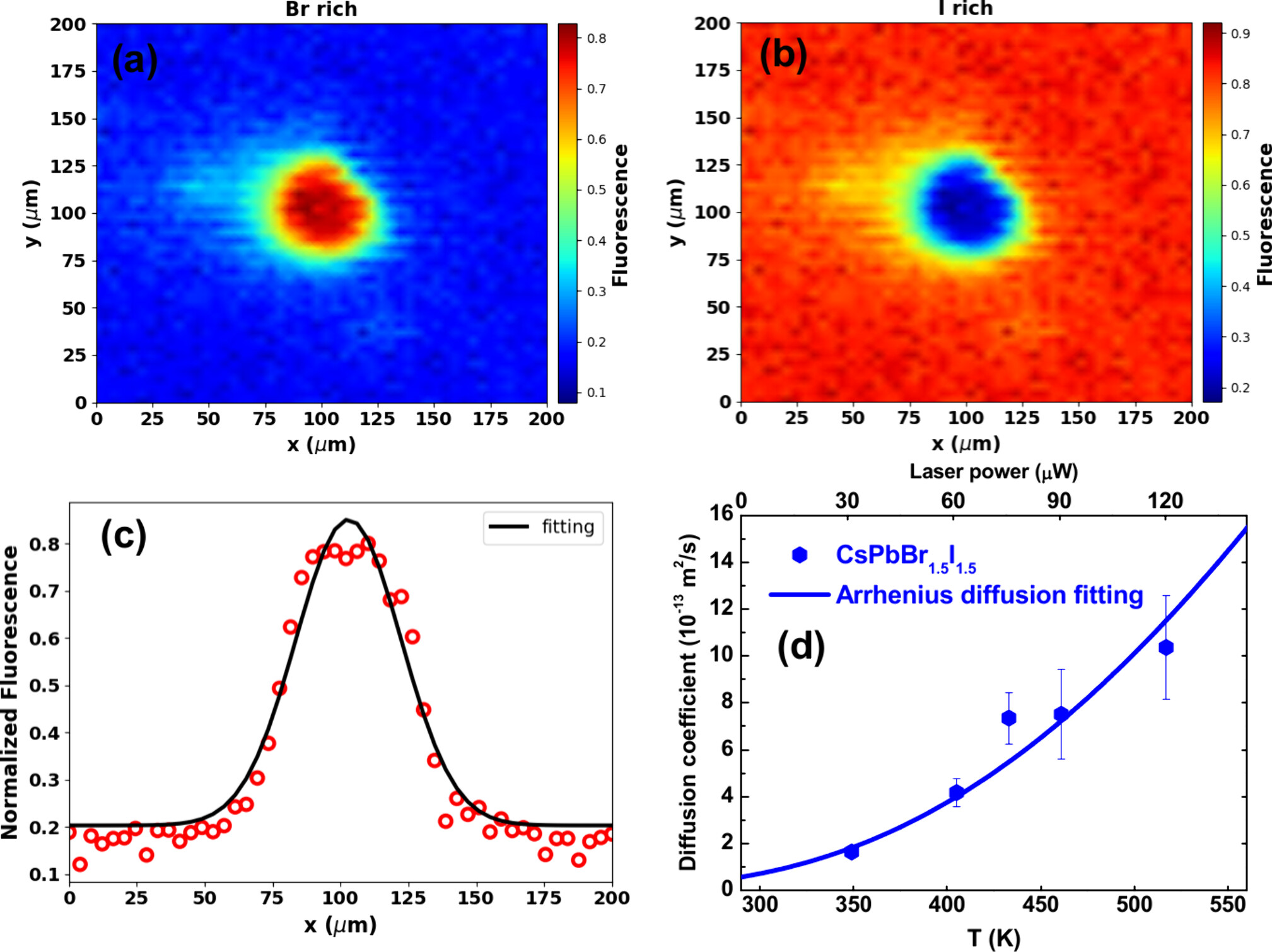Transition from light-induced phase reconstruction to Halide segregation in CsPbBr3-xIx nanocrystal thin films.
CUNHA, Thiago Rodrigues da; FERREIRA, Diego Lourençoni; MAGALHÃES, Letícia Ferreira; CARVALHO, Thaís Adriany de Souza; SOUZA, Gabriel Fabrício de; BETTINI, Jefferson; FACETO, Angelo Danilo; MENDONÇA, Cleber Renato; DE BONI, Leonardo; SCHIAVON, Marco Antonio; VIVAS, Marcelo Gonçalves.
CUNHA, Thiago Rodrigues da; FERREIRA, Diego Lourençoni; MAGALHÃES, Letícia Ferreira; CARVALHO, Thaís Adriany de Souza; SOUZA, Gabriel Fabrício de; BETTINI, Jefferson; FACETO, Angelo Danilo; MENDONÇA, Cleber Renato; DE BONI, Leonardo; SCHIAVON, Marco Antonio; VIVAS, Marcelo Gonçalves.




 Abstract: Inorganic metal-halide perovskite materials pave the way for many applications ranging from optoelectronics to quantum information due to their low cost, high photoluminescence and energy conversion efficiencies. However, light-induced bandgap instability due to ion migration in mixed-halide perovskites remains a significant challenge to the efficiency of optoelectronic devices. Thus, we combined hyperspectral fluorescence microspectroscopy and computational methods to understand the underlying transition mechanism between phase reconstruction and segregation in CsPbBr3-xIx (0 < x < 3) nanocrystal thin films. Our outcomes have shown that samples with x = 1.0 and x = 1.5 exhibit halide migration, favoring Br enrichment locally. In this case, an interplay between photo and thermal activation promotes the expulsion of I? from the perovskite lattice and generates a reconstruction of Br-rich domains, forming the CsPbBr3 phase. Thus, thermodynamic parameters such as the halide activation energy and phase reconstruction diffusibility were obtained by combining the kinetic parameters from linear unmixing data and Fick?s second law. Moreover, we observed that the Br?I interdiffusion followed an Arrhenius-like behavior over laser-induced temperature increase. On the other hand, for samples with x = 2.0, phase segregation occurred due to the larger CsPbBrI2 nanocrystal size, iodine content and the high laser intensity employed. These three combined effects modify transport and recombination due to the reduction of charge carrier diffusion length (LD = 10.2 nm) and bandgap. Thus, iodide ions diffuse from the nanocrystal surface to the core forming a ?type-II heterostructure?, promoting a red shift in the fluorescence spectrum, which is characteristic of phase seg Finally, the possible halide migration mechanism and physical origins of the transition between these phenomena are pointed out.
Abstract: Inorganic metal-halide perovskite materials pave the way for many applications ranging from optoelectronics to quantum information due to their low cost, high photoluminescence and energy conversion efficiencies. However, light-induced bandgap instability due to ion migration in mixed-halide perovskites remains a significant challenge to the efficiency of optoelectronic devices. Thus, we combined hyperspectral fluorescence microspectroscopy and computational methods to understand the underlying transition mechanism between phase reconstruction and segregation in CsPbBr3-xIx (0 < x < 3) nanocrystal thin films. Our outcomes have shown that samples with x = 1.0 and x = 1.5 exhibit halide migration, favoring Br enrichment locally. In this case, an interplay between photo and thermal activation promotes the expulsion of I? from the perovskite lattice and generates a reconstruction of Br-rich domains, forming the CsPbBr3 phase. Thus, thermodynamic parameters such as the halide activation energy and phase reconstruction diffusibility were obtained by combining the kinetic parameters from linear unmixing data and Fick?s second law. Moreover, we observed that the Br?I interdiffusion followed an Arrhenius-like behavior over laser-induced temperature increase. On the other hand, for samples with x = 2.0, phase segregation occurred due to the larger CsPbBrI2 nanocrystal size, iodine content and the high laser intensity employed. These three combined effects modify transport and recombination due to the reduction of charge carrier diffusion length (LD = 10.2 nm) and bandgap. Thus, iodide ions diffuse from the nanocrystal surface to the core forming a ?type-II heterostructure?, promoting a red shift in the fluorescence spectrum, which is characteristic of phase seg Finally, the possible halide migration mechanism and physical origins of the transition between these phenomena are pointed out. @article={003238772,author = {CUNHA, Thiago Rodrigues da; FERREIRA, Diego Lourençoni; MAGALHÃES, Letícia Ferreira; CARVALHO, Thaís Adriany de Souza; SOUZA, Gabriel Fabrício de; BETTINI, Jefferson; FACETO, Angelo Danilo; MENDONÇA, Cleber Renato; DE BONI, Leonardo; SCHIAVON, Marco Antonio; VIVAS, Marcelo Gonçalves.},title={Transition from light-induced phase reconstruction to Halide segregation in CsPbBr3-xIx nanocrystal thin films},journal={ACS Applied Materials and Interfaces},note={v. 17, n. 9, p. 14389-14403 + supporting information},year={2025}}
@article={003238772,author = {CUNHA, Thiago Rodrigues da; FERREIRA, Diego Lourençoni; MAGALHÃES, Letícia Ferreira; CARVALHO, Thaís Adriany de Souza; SOUZA, Gabriel Fabrício de; BETTINI, Jefferson; FACETO, Angelo Danilo; MENDONÇA, Cleber Renato; DE BONI, Leonardo; SCHIAVON, Marco Antonio; VIVAS, Marcelo Gonçalves.},title={Transition from light-induced phase reconstruction to Halide segregation in CsPbBr3-xIx nanocrystal thin films},journal={ACS Applied Materials and Interfaces},note={v. 17, n. 9, p. 14389-14403 + supporting information},year={2025}}